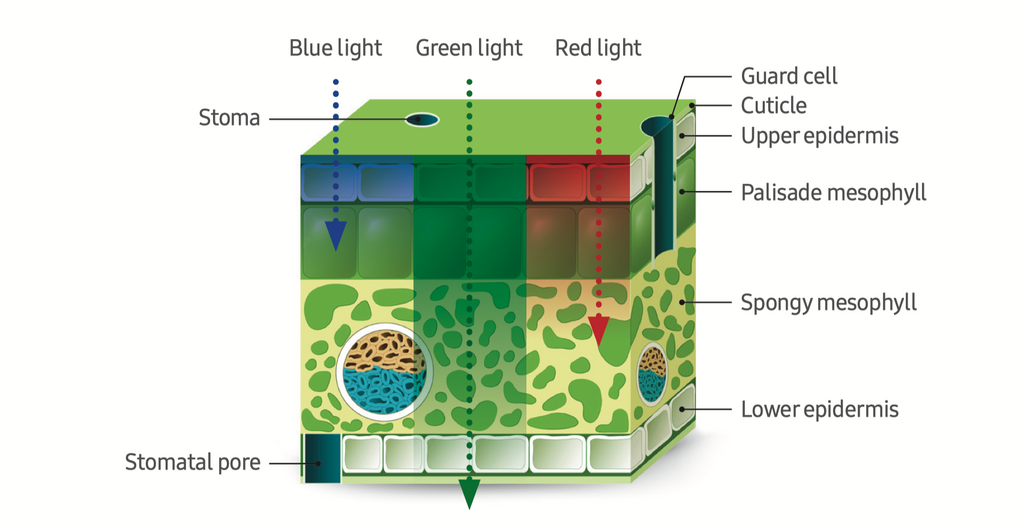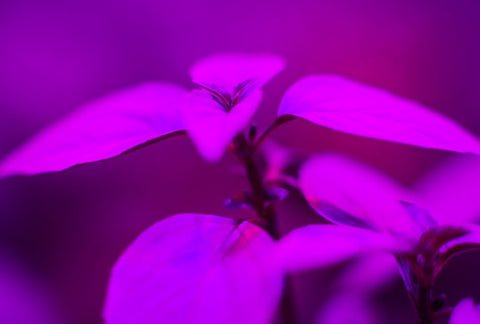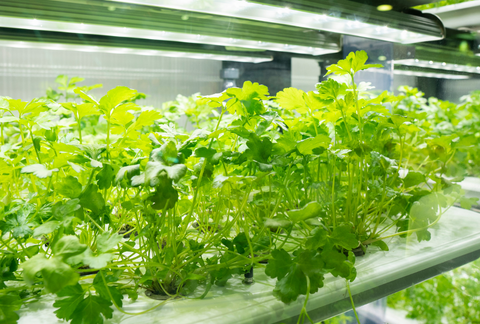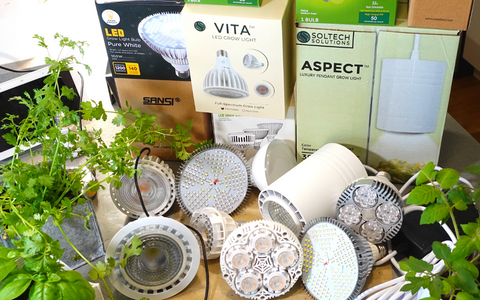Have you ever wondered why some grow lights are purple? Do purple grow lights actually work better for plants? What are the benefits of a purple vs. a white grow light?
In this article, we will explain both the science and history of why some grow lights continue to be purple, as well as offer three key reasons why we think you should avoid purple grow lights (and use a full spectrum 'white' one instead).
This blog is also available as a YouTube video.
Why Are Some Grow Lights Purple?
The Science Behind Purple Grow Lights
The most succinct answer to the question of why many grow lights emit a purple-looking light is that they consist of red and blue LEDs (or 'Light Emitting Diodes'). When you mix red and blue together, you get purple.
Scientists, horticulturalists, and LED manufacturers have focused on the red and blue frequencies of light as these frequencies of light are two of the most important for photosynthesis.
As noted by Yan et al:
- Red light plays an important role in controlling the functions of the chloroplast, stem and petiole growth, and the reproductive system. In other words, red light is important for fruiting and flowering.
- Blue light affects plant growth, leaf expansion, photomorphogenesis, stomatal opening, photosynthesis, and pigment accumulation. That means that blue light is important for vegetative growth.
Essentially, the idea behind purple grow lights is to focus only on the most important light frequencies and forget about the rest. This is a fine idea in theory; however, as researchers and scientists learn more about how plants respond to other light frequencies, it is becoming increasingly apparent that while red and blue are important, they are not the only frequencies of light important for plant health. More on this below. Let’s first take a quick history lesson to understand how we got here.
Why Are Grow Lights Purple? A Brief History
The world’s first LED was red in color and invented over 50 years ago in 1962 by General Electric employee Nick Holonyak, Jr.
By the early 1970s, we had figured out how to make green LEDs, and by combining them with the original red ones, we were able to make yellow. Now, in case you’re casting your mind back to kindergarten paint classes and thinking “red + green = yellow” doesn’t sound right, remember that mixing light doesn’t work the same way as mixing paint does. See below.

It wasn’t until 1994 that Shuji Nakamura used Gallium Nitride to make the world’s first blue LED. By combining red, green, and blue, we were able to generate a LED light that looks white to our human eyes (see the RGB diagram above).
Philips was the first company to produce LEDs with the Edison screw fitting in 2009, which means that even if you had the oldest LED screw light in the world, it’s not even 15 years old!
Like most technologies, when they first came out LEDs were pretty lousy in terms of cost and efficiency – but they’ve come a long way since, as the chart below illustrates.
So how is all this relevant to today’s purple grow lights? Glad you asked. In the remainder of this article, we will cover the three key reasons why we think you should avoid purple grow lights.
Reason 1 – The Economics of Purple Grow Lights Don’t Make Sense for At-Home Growers
Early manufacturers of LED grow lights recognized that they could essentially ‘construct’ any light recipe they wanted using specific combinations of LEDs, and given that 1) they didn’t know as much about plant health as we do today, and 2) LEDs were expensive and not that efficient at the time, they opted to leave out all of the 'non-essential' frequencies of light and focus on delivering only those frequencies that were absolutely critical to plant growth. And hey – we get it. Once upon a time, this was a very sensible approach.
But the times have changed. LED technology has gotten much cheaper and more efficient over the last decade. Both the cost of manufacturing and the cost of operating these lights have come down significantly. What that means is that the cost savings you get from omitting these 'non-core' (i.e., non-red and non-blue) light frequencies are far less than they once were.
A typical 10-30W grow light for indoor plants is going to cost less than $20 a year in electricity. The savings associated with leaving out the 'non-core' light frequencies are therefore only a dollar or two per year in terms of electricity cost savings.
Now, don’t get us wrong – we’re all for being energy efficient, and if you were going to fill an entire warehouse with grow lights and run a vertical farming operation then sure – purple grow lights might make more sense. But given the other disadvantages of purple lights (see below) we think this historical efficiency argument just doesn’t have the weight it once did.
Reason 2 – Red and Blue Frequencies Are Not the Only Ones That Are Important for Plant Health

Source: Samsung
Much of the ‘foundational’ knowledge we have about grow lights came from the latter part of the 20th century. It includes:
- The McCree Curve
- The ‘importance’ of red and blue light
- The idea that PAR is only 400-700nm and frequencies outside this range don’t matter to plants
The problem is that when McCree et al did their work on how plants respond to light, they only had access to light filters and analog equipment, and were only able to assess plants’ response to light one color at a time. They did not consider how these light frequencies work together and complement each other, nor did they have access to the sophisticated measuring equipment that we have today. As a result, a lot of this ‘foundational’ grow light knowledge is now in the process of being proven wrong.
The invention of single-color LEDs has allowed us to learn much more about how plants respond to light. Professor Bruce Bugbee of Utah University is one of the leading researchers in this field. Thanks to the work of Professor Bugbee and others, we now understand that:
- UVA / UVB (less than 400nm) impacts essential oils, taste, and flavor
- Green light is incredibly good at canopy and leaf penetration, much more so than red and blue
- Far-red light (700-760nm, not even counted as ‘PAR’ light) enhances cell expansion and is a particularly good complement to blue light
To purchase a blue/red (purple) grow light means you are ignoring the last 20 years of research and science on how plants respond to light. We just don’t think that ignoring science is a smart thing to do. Since we are believers in science and using it to our advantage, you will only find FULL spectrum grow lights for sale in our store.
The charts below compare plant yield under 'narrow' (i.e., only red and blue) vs. 'full spectrum' lighting scenarios.

Reason 3 – Purple Grow Lights Are Just Not That Pleasant to Live With
The first ever ‘beta’ test we performed at Urban Leaf involved setting up a group of about 12 people with a very basic Kratky hydroponic setup and a grow light. We split the group in two – half had white lights and the others purple. Although the purple light users thought they were ‘cool’ at first, the novelty quickly wore off. By the end of our trial, most of the purple grow light users had either found a way to cover their units with a cloth to shade the light, or they’d relocated them to a cupboard or wardrobe.
Given the hours we’d spent assembling these units by hand, we were pretty disheartened to see people going to these extents to ‘hide’ our products. It taught us however that purple light is just not a pleasant color to have in a living space.
Want another reason? Purple light is also shown to make you feel sleepy. Doesn’t sound very fun, if you ask us :)
Purple vs. White LED Grow Lights – A Better Option?
Hopefully by now, it is clear why we do not recommend purple grow lights for small-scale at-home growers who are looking to set up a garden in their living space.
A better choice, in our opinion, is a full spectrum light that will ensure optimal plant health and a more pleasant environment for you, too. The Kelvin scale is a useful reference for evaluating ‘white’ grow lights. If you live in a very hot environment, and you want the inside of your home to feel cool then look for a light rated 5000-5500K. The spectral distribution of these lights skews towards blue making them feel a little cooler. If you live in a colder climate or have a small space, we recommend a warmer light temperature, in the 2700 – 3500K range. These skew red, and have a warmer glow, making them arguably a little better for fruiting and flowering compared to a higher K globe which would be better for vegetative growth.
Which Is the Best Grow Light for You?
Hopefully by now we have convinced you to go with a full spectrum light. If so, then here are some of our top recommendations for various gardening setups:
- Best Hanging Option: If you have a wall or ceiling from which to hang your light, then the Aspect grow light is the way to go. It comes in white and black, as well as 20W or 40W.
- Best Free Standing Option: If you'd rather not be drilling holes in your ceiling/wall, then a great alternative is to get a free standing option like the PlantSpectrum. The small is 16" and 16W, and large is 32" and 32W. They are not only incredibly versatile in terms of mounting options, but they have the added benefit of being water proof.
- Best Under-Cabinet Option: If you're looking to grow on a bookshelf or countertop, then you should definitely check out the Grove. It has a number of mounting options (like the PlantSpectrum) and comes in at a more affordable price point.
- Most Versatile Option: If you live in a rental, move around a lot, or just want future flexibility - then a Vita is your best bet. This is available as both a stand-alone globe, as well as in a pendant kit. We also offer options in black/white and narrow/wide beam angle. Its E26 fitting is compatible with any standard screw-style housing (i.e., desk lamp, lamp stand, or pendant light).
- Best Budget Option: If you're just looking for something cheap and simple for seed starting or a single herb plant, then we do also offer a compact option. This unit is not suitable for large grow areas or fruits/vegetables, however.
If you’d like to learn more about finding the perfect grow light for your at-home setup, we recommend Growing Plants Under Lights: A Guide To Buying Your First Grow Light.









Thanks. Appreciate this information. Been working with LEDs for years but not for growing. Bough a couple grow lights from a farm store (Rural King) and they are supposedly full spectrum and seem to work, but still look purple. Bought a couple grow lights from amazon and one out of two failed after 3.5 months. Want to buy/build an indoor “green house” plant shelving for seedlings and researching information on new lights. Did not see dimensions (length) on the Grove LED Grow Light; gusstimate 18 inches??
Recommend letting the audiance know what is recommended:
Brightness: 2000 – 4500 Lux?
Color Temperature: 3500 – 6000 Kelvin ?